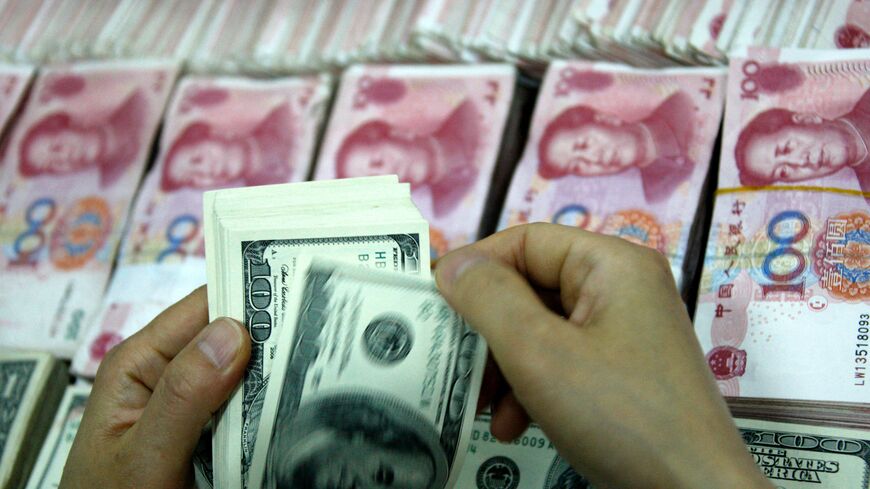As Saudi Arabia eyes entry into the BRICS group of nations, there are fears that the kingdom’s vast oil reserves alongside China’s economic power could be a blow to the US dollar. But past experiences in Pakistan, along with the yuan’s peg to the dollar, indicate these concerns may be overblown.
Soon after Saudi Arabia formally joined the Shanghai Cooperation Organization (SCO) as a dialogue member in late March, it now appears Riyadh will be participating in the upcoming BRICS summit this August in an effort to formalize its inclusion in the economic bloc.
Consisting of Brazil, Russia, India, China and South Africa, the BRICS group of nations requires the consensus of present members to admit new states. Having elicited the interest of countries like Turkey, Egypt, Iran, UAE and Saudi Arabia, the consortium seems set to grow into a global powerhouse.
Ever since the news last month that Riyadh is considering accepting yuan as a currency to price some oil sales to China, the perception that Saudi Arabia’s participation in BRICS would be a gamechanger for the existing economic system has received fresh impetus.
Ashok Swain, a professor of peace and conflict research at Uppsala University in Sweden, told Al Monitor that oil trade in yuan — also known as renminbi — will be a “huge step” for China. It would also “be a significant setback to the dollar's standing,” he noted. “There is no doubt that Saudi Arabia becoming a member of China-dominated SCO and BRICS+ would accelerate the bilateral trading being conducted using the yuan as the trading currency.”
Russia has also started using the yuan as a settlement currency, while Beijing has signed an agreement with Brazil to use it for cross-border transactions. In tandem, there are indications that the BRICS members would discuss developing a new form of currency.
On the sidelines of the India-Russia Business Forum in late March in New Delhi, Alexander Babakov, the deputy chairman of the Russian State Duma, said, “The transition to settlements in national currencies is the first step. The next one is to provide the circulation of digital or any other form of a fundamentally new currency in the nearest future.”
Not a major global currency
Notwithstanding these expectations, the Chinese yuan/renminbi remains a relatively smaller global currency player.
Torek Farhadi, a financial analyst based in Geneva, told Al Monitor, “The yuan trend is not a major risk to the US dollar. Roughly, 58% of global trade is still in US dollars, albeit it has come down from above 75% over the last 15 years, but that is mostly due to increase in trade in euro."
In practice, 95% of world dollar payments are made using SWIFT (the Society for Worldwide Interbank Financial Telecommunications) and around 11,000 member institutions in 200 nations and territories, carry out nearly 42 million transactions per day, with the average daily amounts being almost $5 trillion.
Meanwhile, the yuan remains pegged to the dollar so that it does not float, or get exposed to market forces. Chinese monetary authorities adjust the currency value to benefit Beijing’s exports. Also, the Chinese capital account remains closed, and capital cannot flow out without approval.
Considering the yuan’s limitations, what has really caused this wish for de-dollarization?
Wishing to avoid complete dependency on the dollar as well as the threat of US sanctions, various global powers seem to have made contingency plans, even though there may be little or no immediate benefit.
Only last year, Western sanctions cut Russia off from its foreign currency reserves after it attacked Ukraine. As a result, the yuan surpassed the dollar as the most traded currency in Russia.
Next, after Chinese President Xi Jinping’s trip to Riyadh last December to participate in the first China-GCC Summit, Beijing’s geo-economic strategy has entered a practical phase. As more of Beijing’s close allies start using the yuan as a settlement currency, it illustrates China’s growing influence.
In the Middle East, China can easily insist on using the yuan for payments as it is a major oil consumer.
Zubair Faisal Abbasi, a development policy and management specialist based in Islamabad, told Al-Monitor that as China increases its trade with the GCC countries, especially Saudi Arabia and the UAE, "payment and settlement can be in yuan, although pricing still can continue in USD. Recently, several banks in Dubai issued foreign bonds in yuan in 2021.”
Symbolically, bringing down the dollar may have become necessary for Beijing. “The dollar helps the US maintain its global domination, which is why China is eager to break that and make the yuan the alternative to the US dollar in this increasingly bipolar world," Swain said. "Yuan reserve is steadily increasing in many Asian and African countries.”
Peg to dollar is complication
Though there are fears that the yuan could displace the dollar from its position as a reserve currency, most oil trade is still settled in dollars, and so long as the yuan remains linked to the dollar, it is not possible to know its real market value.
Farhadi said, “China still likes the US dollar to keep its status as its customers in the US are paying for Chinese imports in dollars. China also holds considerable US debt denominated in US dollars, and a weakening of the dollar would translate into an erosion of the value of the US debt China holds.”
In Pakistan, an official yuan settlement system was launched for bilateral trade in 2018. As per the State Bank of Pakistan, a comprehensive bank policy was prepared so that public and private enterprises in both countries could carry out financial activities in yuan, but the yuan is nowhere close to reducing the usage and demand of the dollar in Pakistan.
Abbasi said that Pakistan and China signed a currency swap agreement (CSA) in 2011, but no significant progress has been made, and in 2020-21, the bilateral trade was in Chinese currency worth 30 billion yuan ($4.5 billion).
He added, “It is estimated that if the CSA is fully operationalized with clearing arrangements, and CPEC also picks up lost speed, it can enable Pakistani traders to clear all import payments to China ($18 billion) in yuan. It will also lower dependence on US dollar reserves. However, Pakistan has not significantly benefited from the CSA.”
Lacking any viable alternative, and going by the amount of usage, it seems that the US dollar will remain dominant in global trade. For now, the yuan may become just a more widely used international currency.








